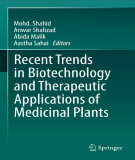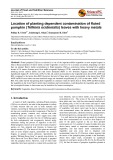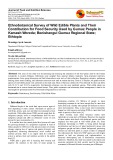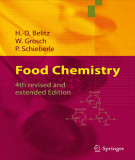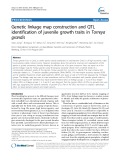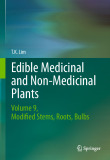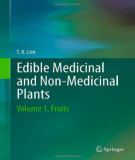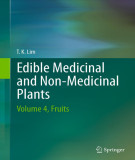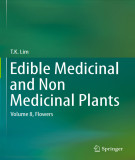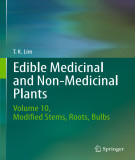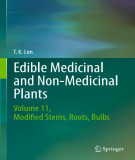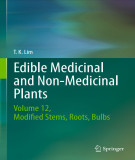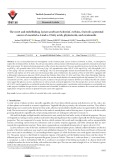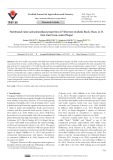
Edible plant
-
Ebook "Recent trends in biotechnology and therapeutic applications of medicinal plants" provides an overview of current trends in biotechnology and medicinal plant sciences. The work includes detailed chapters on various advance biotechnological tools involved in production of phytoactive compounds of medicinal significance. Some recent and novel research studies on therapeutic applications of different medicinal plants from various geographical regions of the world have also been included.
 359p
359p  coduathanh1122
coduathanh1122
 27-03-2024
27-03-2024
 2
2
 1
1
 Download
Download
-
Fluted pumpkin (Telfeiria occidentalis) is one of the important edible vegetables in most tropical regions in Africa. Bioaccumulation of heavy metals in leafy vegetables is known to be a common occurrence, depending on where they are planted.
 5p
5p  viisac
viisac
 23-09-2023
23-09-2023
 3
3
 0
0
 Download
Download
-
The aims of this study was documenting and assessing the utilization of the food plants used by the Gumuz community in western Ethiopia. Informants were sampled from selected kebeles randomly. Semi-structured interview, questionnaires, focus group discussion and field observations were tools of data collection.
 8p
8p  viisac
viisac
 23-09-2023
23-09-2023
 2
2
 1
1
 Download
Download
-
Musa sapientum, commonly known as banana is an elongated, edible fruit – botanically a berry produced by several kinds of large herbaceous flowering plants. Banana peels have the potentials to support microbial growth. This research was focused on the fresh peels of three banana species (Musa acuminata, Musa balbisiana and Musa paradisiaca).
 5p
5p  viisac
viisac
 23-09-2023
23-09-2023
 1
1
 1
1
 Download
Download
-
Continued part 1, part 2 of ebook "Food chemistry (4th revised and extended edition)" provides readers with contents including: food contamination; milk and dairy products; eggs; meat; fish, whales, crustaceans, mollusks; edible fats and oils; cereals and cereal products; legumes; vegetables and vegetable products; fruits and fruit products; sugars, sugar alcohols and honey; alcoholic beverages; coffee, tea, cocoa; spices, salt and vinegar; drinking water, mineral and table water;...
 604p
604p  lytamnguyet
lytamnguyet
 04-08-2023
04-08-2023
 8
8
 4
4
 Download
Download
-
Genetic linkage map construction and QTL identification of juvenile growth traits in Torreya grandis
Torreya grandis Fort. ex Lindl, a conifer species widely distributed in Southeastern China, is of high economic value by producing edible, nutrient seeds. However, knowledge about the genome structure and organization of this species is poorly understood, thereby limiting the effective use of its gene resources.
 9p
9p  vinarcissa
vinarcissa
 21-03-2023
21-03-2023
 1
1
 1
1
 Download
Download
-
Ebook "Edible medicinal and non-medicinal plants - Volume 9: Modified stems, roots, bulbs" is part of a multicompendium Edible Medicinal and Non-Medicinal Plants, on plants with edible modified stems, roots and bulbs from Acanthaceae to Zygophyllaceae (tabular) and 32 selected species in Alismataceae, Amaryllidaceae, Apiaceae, Araceae, Araliaceae, Asparagaceae, Asteraceae, Basellaceae, Brassicaceae and Campanulaceae in detail.
 1047p
1047p  damtuyetha
damtuyetha
 16-02-2023
16-02-2023
 5
5
 1
1
 Download
Download
-
Ebook "Edible medicinal and non-medicinal plants - Volume 3: Fruits" encompasses species from the following families: Ginkgoaceae, Gnetaceae, Juglandaceae, Lauraceae, Lecythidaceae, Magnoliaceae, Malpighiaceae, Malvaceae, Marantaceae, Meliaceae, Moraceae, Moringaceae, Muntigiaceae, Musaceae, Myristicaceae and Myrtaceae. Topics covered include: taxonomy; common/English and vernacular names; origin and distribution; agroecology; edible plant parts and uses; botany; nutritive and pharmacological properties, medicinal uses and research findings; nonedible uses; and selected references.
 916p
916p  damtuyetha
damtuyetha
 16-02-2023
16-02-2023
 4
4
 2
2
 Download
Download
-
Ebook "Edible medicinal and non-medicinal plants - Volume 1: Fruits" devotes over 800 pages to plant families whose names begin with the first three letters of the Latin alphabet starting with Actinidiaceae (kiwi fruit) and ending with Cycadaceae (cycads). The author summarizes antioxidant, anti-cancer, and antimicrobial activities of the plants, along with reports of antivenin, radioprotective, and anti-aging properties, some of which are cited in preliminary studies only. Summing Up: Recommended. Upper-division undergraduates and above; informed general readers.
 852p
852p  damtuyetha
damtuyetha
 16-02-2023
16-02-2023
 1
1
 1
1
 Download
Download
-
Ebook "Edible medicinal and non-medicinal plants - Volume 2: Fruits" covers edible fruits/seeds used fresh or processed, as vegetables, spices, stimulants, pulses, edible oils and beverages. It encompasses species from the following families: Clusiaceae, Combretaceae, Cucurbitaceae, Dilleniaceae, Ebenaceae, Euphorbiaceae, Ericaceae and Fabaceae.
 1112p
1112p  damtuyetha
damtuyetha
 16-02-2023
16-02-2023
 3
3
 1
1
 Download
Download
-
Ebook "Edible medicinal and non-medicinal plants - Volume 4: Fruits" encompasses selected species from the following families: Fagaceae, Grossulariaceae, Hypoxidaxeae, Myrsinaceae Olacaceae, Oleaceae, Orchidaceae, Oxalidaceae, Pandanaceae, Passifloraceae, Pedaliaceae, Phyllanthaceae, Pinaceae, Piperaceae, Rosaceae and Rutaceae. Topics covered include: taxonomy; common/English and vernacular names; origin and distribution; agroecology; edible plant parts and uses; botany; nutritive and pharmacological properties, medicinal uses and research findings; nonedible uses; and selected references.
 1037p
1037p  damtuyetha
damtuyetha
 16-02-2023
16-02-2023
 6
6
 1
1
 Download
Download
-
Ebook "Edible medicinal and non-medicinal plants - Volume 5: Fruits" covers selected species from the following families: Apiaceae, Brassicaceae, Chenopodiaceae, Cunoniaceae, Lythraceae, Papaveraceae, Poaceae, Polygalaceae, Polygonaceae, Proteaceae, Ranunculaceae, Rhamnaceae, Rubiaceae, Salicaceae, Santalaceae, Xanthorrhoeaceae and Zingiberaceae. Topics covered include: taxonomy; common/English and vernacular names; origin and distribution; agroecology; edible plant parts and uses; botany; nutritive/pharmacological properties, medicinal uses, nonedible uses; and selected references.
 954p
954p  damtuyetha
damtuyetha
 16-02-2023
16-02-2023
 1
1
 1
1
 Download
Download
-
Ebook "Edible medicinal and non-medicinal plants - Volume 6: Fruits" covers selected species from the following families: Sapindaceae, Sapotaceae, Schisandraceae, Solanaceae, Thymelaeaceae, Urticaceae, Vitaceae and Winteraceae. Topics covered include: taxonomy; common/English and vernacular names; origin and distribution; agroecology; edible plant parts and uses; botany; nutritive and pharmacological properties, medicinal uses and research findings; nonedible uses; and selected references.
 617p
617p  damtuyetha
damtuyetha
 16-02-2023
16-02-2023
 2
2
 1
1
 Download
Download
-
Ebook "Edible medicinal and non-medicinal plants - Volume 7: Flowers" covers plant species with edible flowers from families Acanthaceae to Facaceae in a tabular form and seventy five selected species from Amaryllidaceae, Apocynaceae, Asclepiadaceae, Asparagaceae, Asteraceae, Balsaminaceae, Begoniaceae, Bignoniaceae, Brassicaceae, Cactaceae, Calophyllaceae, Caprifoliaceae, Caryophyllaceae, Combretaceae, Convolvulaceae, Costaceae, Doryanthaceae and Fabaceae in detail.
 1115p
1115p  damtuyetha
damtuyetha
 16-02-2023
16-02-2023
 3
3
 1
1
 Download
Download
-
Ebook "Edible medicinal and non-medicinal plants - Volume 8: Flowers" is part of a multi-compendium Edible Medicinal and Non-Medicinal Plants, on plants with edible flowers from Geraniaceae to Zingiberaceae (tabular) and 82 species in Geraniaceae, Iridaceae, Lamiaceae, Liliaceae, Limnocharitaceae, Magnoliaceae, Malvaceae, Meliaceae, Myrtaceae, Nyctaginaceae, Nymphaeaceae, Oleaceae, Onagraceae, Orchidaceae, Paeoniaceae, Papaveraceae, Plantaginaceae, Poaceae, Polygonaceae, Primulaceae, Proteaceae, Ranunculaceae, Rosaceae, Rubiaceae, Rutaceae, Solanaceae, Theaceae, Tropaeolaceae, Tyhpaceae, Vi...
 1038p
1038p  damtuyetha
damtuyetha
 16-02-2023
16-02-2023
 4
4
 1
1
 Download
Download
-
Ebook "Edible medicinal and non-medicinal plants - Volume 10: Modified stems, roots, bulbs" with 59 plant species with edible modified stems, roots and bulbs in the families Amaranthaceae, Cannaceae, Cibotiaceae, Convolvulaceae, Cyperaceae, Dioscoreaceae, Euphorbiaceae, Fabaceae, Iridaceae, Lamiaceae, Marantaceae, Nelumbonaceae, Nyctaginaceae, Nymphaeaceae, Orchidaceae, Oxalidaceae, Piperaceae, Poaceae, Rubiaceae, Simaroubaceae, Solanaceae, Tropaeolaceae, Typhaceae and Zingiberaceae.
 670p
670p  damtuyetha
damtuyetha
 16-02-2023
16-02-2023
 2
2
 1
1
 Download
Download
-
Ebook "Edible medicinal and non-medicinal plants - Volume 11: Modified stems, roots, bulbs" covers selected plant species with edible modified stems, roots and bulbs in the families Iridaceae, Lamiaceae, Marantaceae, Nelumbonaceae, Nyctaginaceae, Nymphaeaceae, Orchidaceae, Oxalidaceae, Piperaceae, Poaceae, Rubiaceae and Simaroubaceae. The edible species dealt with in this work include wild and underutilized crops and also common and widely grown ornamentals.To help in identification of the plant and edible parts coloured illustrations are included.
 403p
403p  damtuyetha
damtuyetha
 16-02-2023
16-02-2023
 5
5
 1
1
 Download
Download
-
Ebook "Edible medicinal and non-medicinal plants - Volume 12: Modified stems, roots, bulbs" covers selected plant species with edible modified stems, roots and bulbs in the families Solanaceae, Tropaeolaceae and Zingiberaceae. The edible species dealt with in this work include wild and underutilized crops and also common and widely grown ornamentals. To help in identification of the plant and edible parts coloured illustrations are included.
 701p
701p  damtuyetha
damtuyetha
 16-02-2023
16-02-2023
 6
6
 1
1
 Download
Download
-
In our current phytochemical investigation on the Tunisian plant Lycium arabicum Schweinf. ex Boiss., we attempted to explore the oil obtained from its fruits. This oil was extracted by cold maceration with ethanol and was analyzed to estimate its sterol and fatty acid content. The physicochemical parameters of the oil were also examined. They were specified in terms of acid value (0.8 ± 0.01 mg KOH g–1 oil), peroxide value (10.9 ± 0.02 meq O2 kg–1 oil), saponification value (162.97 ± 0.03 mg KOH g–1 oil), chlorophylls (1.011 ± 0.03 mg kg–1 oil) and carotenoids (42.1 ± 0.05mg kg–1 oil).
 14p
14p  lyhuyenthu
lyhuyenthu
 31-01-2023
31-01-2023
 4
4
 2
2
 Download
Download
-
Viburnum mullaha is a popular wild edible fruit widely distributed in Nepal’s mid-hills. Locals consume the fruits of the plants raw and use them to treat a variety of diseases. High value of fat (15%) and protein (3.94%) was evaluated in the seed compared to the pulp with fat 2.1% and protein 1.17%. Both the pulp and the seed exhibited high values of total phenolic content (3346.1 1 ± 0.05 and 2331.03 ± 0.02 mg QAEs/100 g respectively).
 9p
9p  lyhuyenthu
lyhuyenthu
 31-01-2023
31-01-2023
 6
6
 2
2
 Download
Download
CHỦ ĐỀ BẠN MUỐN TÌM








